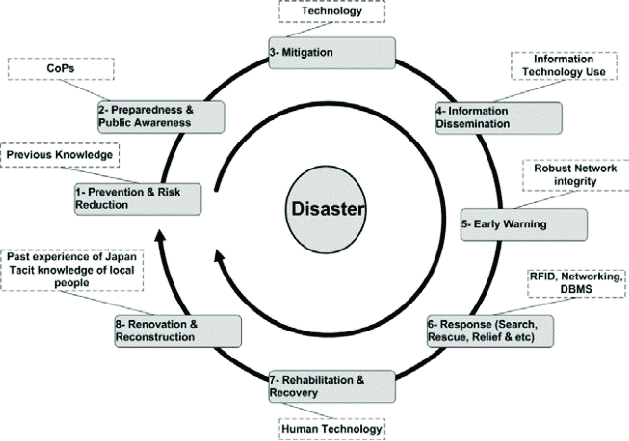Urban Cities and Disaster Management
Figure 2: No Copyright Infringement Intended
Context:
- Recent unexpected heavy rains in Chennai conclude a season of monsoon floods and urban paralysis, highlighting the risk of extreme weather events.
Urban City and disaster management
- Disaster Vulnerability in India: According to the National Disaster Management Agency, about 12% of India's total land area is flooded, 68% is prone to droughts, landslides and avalanches, and 58.6% of land is hit by earthquakes.
- Tsunamis and hurricanes are common phenomena on 5,700 km of the 7,516 km coastline. This vulnerable situation makes India one of the most vulnerable countries.
NITI Aayog's Cities Report:
- In a report on India's urban planning capacity reform, NITI Aayog cites the Covid 19 pandemic as an insightful moment highlighting the urgent need for all cities to become healthy cities by 2030.
- There is no doubt that climate impacts will have more fundamental and sustainable impacts on cities.
- It encourages 500 priority cities to participate in the competitive framework and introduce participatory planning tools, surveys and focus group discussions to assess the needs and desires of citizens.
Consequences:
- Uprooting of trees: Extensive tree uprooting caused by hurricanes is affecting the already depleted green coverings of urban areas. Disasters in densely populated urban areas can cause a lot of human casualties.
- Collapse of Infrastructure: Dangerous infrastructure that collapses in an earthquake or tsunami kills more than any other natural disaster such as a tornado or storm.
- Economic loss: The economic loss of a disaster that damages infrastructure can be enormous. The World Bank estimates that annual disaster losses are already close to US $ 520 billion and that disasters put up to 24 million people in poverty each year.
Causes:
- Theme Planning and Municipal Issues: Less than half of all cities have master plans, and even these are informally dominated as both influential elites and poor invasions of commons such as wetlands and riverbanks. increase.
- Low devolution of Power: Neglect of local councils, lack of power, and failure of local government development often cause paralysis of cities during extreme weather.
- Invasion of natural space: The number of wetlands decreased from 644 in 1956 to 123 in 2018, and the current green coverage is only 9%, ideally at least 33%.
- Reliance on Market Power: The invasion of significant commons reflects the extreme reliance on market power to provide affordable urban housing. Most suburban housing investments are government-approved floor plans, as suburban Panchayat has little capacity or funding to create basic infrastructure such as water, sanitation and roads.
- Inadequate drainage infrastructure: crowded drainage, unregulated development, ignorance of natural terrain and hydrogeomorphology make urban floods a man-made disaster. Cities like Hyderabad and Mumbai rely on centuries-old drainage systems that cover only a small part of the core cities.
- Loose implementation: Even though regulatory mechanisms such as environmental impact assessment (EIA) have provisions such as rainwater harvesting and sustainable urban drainage systems, acceptance by users and enforcement authorities remains
Way forward
- Municipal Role: What is needed is a central role for democratically elected local governments to ensure greater inclusion and community awareness. The top-level climate change adaptation sector serves as a liaison to work together with all relevant sectors of the state, including housing and urban development, transportation, water supply, energy, land use, public works and
- Holistic commitment: Large-scale urban floods cannot be contained by local governments alone without coordinated and targeted investment in energy and resources.
- Coordination between different Bodies: The Metropolitan Development Authority, NDMA, State Revenue and Irrigation Department need to be involved in such cooperation with local government agencies.
- Better Urban Planning: All aspects of urban growth, starting with affordable housing, play a central role in adapting to future climate change.
- Environmentally friendly: Biophilic design and environmentally friendly materials can also reduce the increase in carbon emissions during the construction of infrastructure.
- Example: A perfect example of this is Japan, which is regularly exposed to earthquakes. India's disaster resource network should be institutionalized as a collection point for the collection of organized information and equipment.
- Drainage planning: Watershed management and emergency drainage planning should be clearly expressed in policies and legislation. Urban basins are micro-ecological drainage systems formed by topographic contour lines.
- Focus on Documentation and standard operating proceedures: Detailed documentation in this regard must be maintained by authorities not bound by the jurisdiction of the region. Instead, drainage plans should be developed considering natural boundaries such as watersheds rather than government boundaries such as constituencies.
Conclusion
Indian cities are the driving force of economic growth with mass production and consumption, but this sunrise story is threatened by unsustainable urban development in an era of climate change. What is needed is to develop a robust and functional metropolis that can handle floods, heat waves, pollution and mass migration to sustain the economic impetus. Otherwise, Urban India will be a subprime investment.




1.png)
